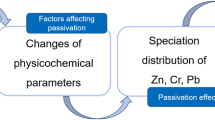Abstract
This paper demonstrated a biocementation technology for chromium slag by strain GM-1, a calcifying ureolytic bacterium identified as Microbacterium, based on microbially induced calcium carbonate. The characterization of Microbacterium sp. GM-1 was assessed to know the growth curve in different concentrations of Cr(VI). Microbacterium sp. GM-1 was tolerant to a concentration of 120 mg/L Cr(VI). Chromium waste forms were prepared using chromium, sand, soil and bacterial culture. There we had three quality ratios (8:2:1; 8:1:1; 8:2:0.5) of material (chromium, sand and soil, respectively). Bacterial and control chromium waste forms were analyzed by thermal gravimetric analyzer. All bacterial forms (8:2:1; 8:1:1; 8:2:0.5 J) showed sharp weight loss near the decomposition temperature of calcium carbonate between 600 and 700 °C. It indicated that the efficient bacterial strain GM-1 had induced calcium carbonate precipitate during bioremediation process. A five step Cr(VI) sequential extraction was performed to evaluate its distribution pattern in chromium waste forms. The percentage of Cr(VI) was found to significantly be decreased in the exchangeable fraction of chromium waste forms and subsequently, that was markedly increased in carbonated fraction after biocementation by GM-1. Further, compressive strength test and leaching test were carried out. The results showed that chromium waste forms after biocementation had higher compressive strength and lower leaching toxicity. Additionally, the samples made of 8:1:1 (m/m/m) chromium + sand + soil were found to develop the highest compressive strength and stand the lowest concentration of Cr(VI) released into the environment.









Similar content being viewed by others
References
Huaifen H, Yuzhu H, Mantong J (2002) Reseach of solidification treament of chromium residue with cement binders and leaching toxicity. Tech Equip Environ Pollut Control 3:9–12
Kogbara RB, Al-Tabbaa A, Yi Y, Stegemann JA (2013) Cementefly ash stabilisation/solidification of contaminated soil: performance properties and initiation of operating envelopes. Appl Geochem 33:64–75
Quan X, Tan H, Zhao Y, Yong H (2006) Detoxification of chromium slag by chromate resistant bacteria. J Hazard Mater B137:836–841
Hongfen Y, Dongwei Z (2012) Application of chromium slag dry harmless treatment technology. J Green Sci Technol 10:125–127
Li X, He C, Bai Y, Ma B et al (2014) Stabilization/solidification on chromium (III) wastes by C3A and C3Ahydrated matrix. Hazard Mater 268:61–67
Tao M, Wenkun Z, Tao D, Youkui Z et al (2014) Coating of microbially produced calcium carbonate precipitation on marble. NonMet Mines 37:11–13
Hongtao H, Xin Z, Qiang J (2011) Research progress of bioremedying in civil engineering. Constr Technol 40:14–17
Wang R, Qian C (2008) Restoration of defects on the surface of cement-based materials by microbiologically precipitated CaCO3. J Chin Ceram Soc 36:457–464
Li P, Qu W (2009) Application of calcium carbonate mineralization material induced by bacterium. J Build Mater 12:482–486
Tessier A, Campbell PGC, Bisson M (1979) Sequential extraction procedure for the speciation of particulate trace metals. Anal Chem 51:8442–8511
Liu F, Zhang X, Chen C (1995) A extration method for total Cr(VI) in chromium sludge. Res Environ Sci 8:40–42
HJ/T299-2007. Solid waste leaching toxic methods—sulfuric acid nitric acid method [S]
GB7023-86. Long-term leaching tests of radioactive waste solids [S]
GB/T15555. 4-1995. The diphenyl hydrazine spectrophotometry method for hexavalent chromium from solid waste [S]
Thornton EC, Amonette JE (1999) Hydrogen sulfide gas treatment of Cr(VI)-contaminated sediment samples from a plating-waste disposal site. Implication for in situ remediation. Environ Sci Technol 33:4096–4101
Peterson ML, Brown GE Jr, Parks GA, Stein CL (1997) Differential redox and sorption of Cr(III/VI) on natural silicate and oxide minerals: EXAFS and XANES results. Geochim Cosmochim Acta 61:3399–3412
Kendelewicz T, Liu P, Doyle CS, Jr B et al (1999) X-ray absorption and photoemission study of the adsorption of aqueous Cr(VI) on single crystal hematite and magnetite surfaces. Surf Sci 424:219–231
Wei Y-L, Chiu S-Y, Tsai H-N, Yang Y-W et al (2002) Thermal immobilization of chromium(VI) in kaolin. Environ Sci Technol 36:4633–4641
Achal V, Pan X, Zhang D, Fu QL (2012) Biomineralization based remediation of As(III) contaminated soil by Sporosarcina ginsengisoli. Hazard Mater 201–202:178–184
Xian X (1989) Effect of chemical forms of cadmium zinc and lead in polluted soils on their uptake by cabbage plants. Plant Soil 113:257–264
Acknowledgments
This research is funded by: (1) Natural Science Foundation of China (Nos. 51274262 and 31300025); (2) Chongqing Science & Technology Commission (No. cstc2014jcyjA20003); (3) Western Ph.D. project, “Western light” talents cultivation plan of Chinese academy of sciences.
Author information
Authors and Affiliations
Corresponding author
Rights and permissions
About this article
Cite this article
Lun, L., Li, D., Yin, Y. et al. Characterization of Chromium Waste Form Based on Biocementation by Microbacterium sp. GM-1. Indian J Microbiol 56, 353–360 (2016). https://doi.org/10.1007/s12088-016-0579-3
Received:
Accepted:
Published:
Issue Date:
DOI: https://doi.org/10.1007/s12088-016-0579-3




